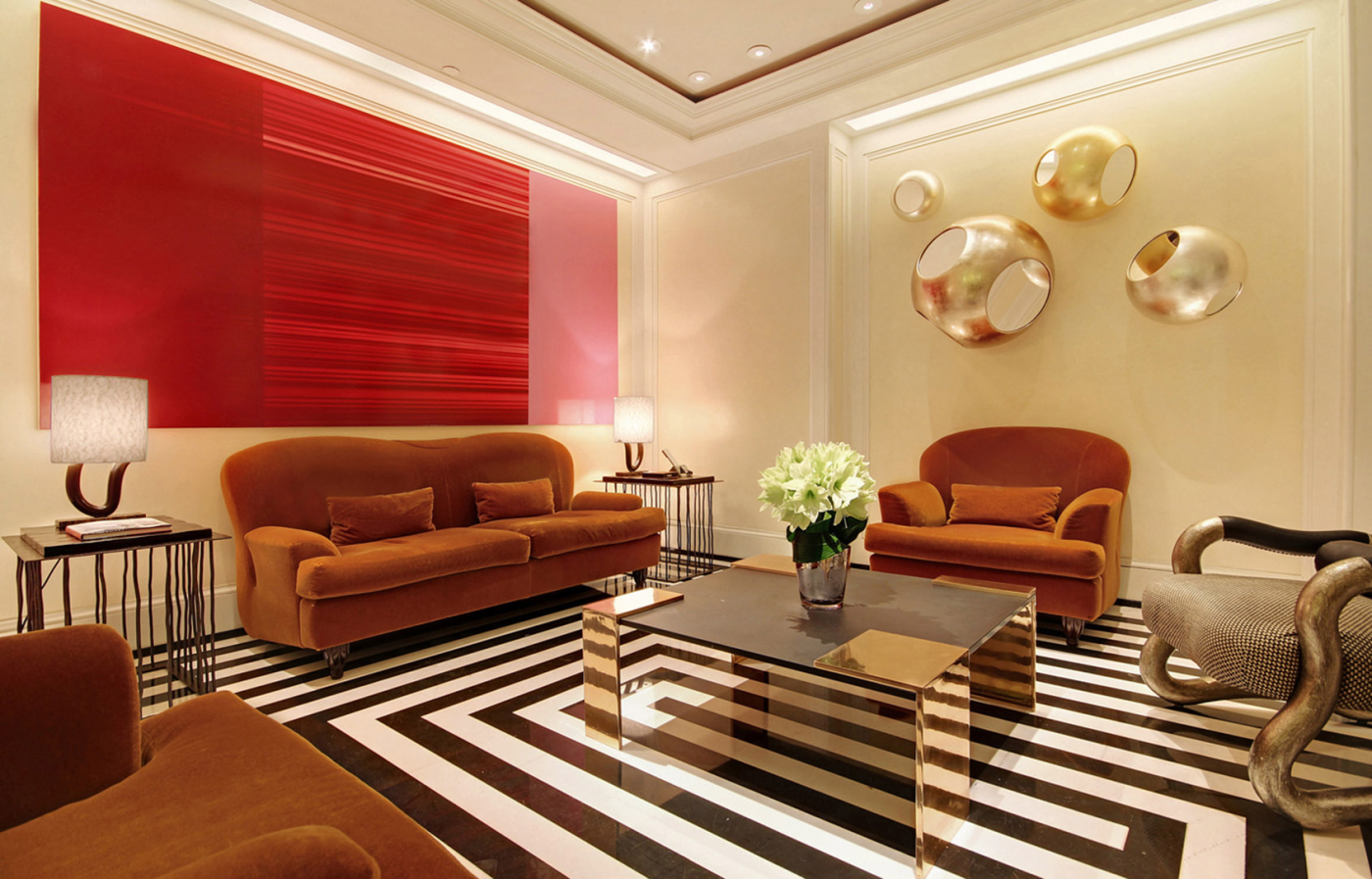Two things never go out of fashion on New York’s Upper East Side: deco styling and soporific lighting. The Mark, on 77th Street at 5th Avenue, forgets neither. It’s a relatively tiny but timeless Manhattan classic. Small is beautiful: throughout the hotel the floors are striped in black and white marble; fixtures, textures, fabrics and colour palettes may differ from room to suite to residence – but that humbug colouring, whether in wider or narrower stripes, doesn’t flag.

The lobby at The Mark, New York
I visited over the Easter weekend, when it was clear from the large family groups and of-a-certain-age couples that this is a place that thrives on repeat visitors. “How is your daughter doing at NYU?” I heard one lady enquire of a server whose home life she clearly knew all about. Jean-Georges Vongerichten’s restaurant menu has reputedly never changed; there would be outcry if its roster of sweet pea soup, fruits de mer, parmesan-crusted chicken, veal Milanese and chocolate mousses and soufflés were ever to change. Quite right too. It’s familiar, comfortable, hugely enjoyable food, prepared exquisitely. For a temporary expat from the UK who happened to be missing Marks & Spencer food, this was hugely welcome. Around the outer edges of some of the plates strutted painted figures of New Yorkers straight from the Big Book of Cultural Clichés: dogwalkers with a brace of purebreds in tow, bag-laden ladies hailing down yellow cabs. They might have been drawn from life, or have strolled in from adjoining Assouline, purveyor of high-end art monographs and coffee table books you’d want to sit down and read, not just flick through. The only character missing was a drawing of a lady with a helmet of Elnett-fixed hair and skyscraping eyebrows to give her a look of permanent wonderment, but one didn’t have to look far on glancing up from the plate to spot at least one of these. A pleasure of hotels and restaurants is the chance they offer the visitor to glimpse the type of parallel life other guests lead: I imagined the lady nearest me at dinner – a spectre barely visible, such was the de rigueur low lighting – emerging each evening from her top-floor residence, creeping downstairs to eat the same dinner every Saturday night.
Perhaps telling us more than he ought, the greeter taking me to my table explained that this wasn’t actually the place they’d planned to seat me, but that a certain guest who’d come down for lunch was still at “my” table, enjoying, one hoped, a very jolly day of it.
Regrettably, not everyone had got the memo that this was a space where relaxation and indulgence were the priority. At the next nearest table, one business type was talking another through a laptop presentation on whose inappropriately bright screen I glimpsed graphs, pie-charts and a disheartening wordle of their company’s strengths (“Sophistication”, “Adaptability”, “Carefulness”) illustrated with a stock photo of a woman in a leotard, doing bicep curls. I felt sorrier than annoyed: neither of the poor devils was drinking.
By contrast, the downstairs bar disposes of all the grown-up design that figures in the rest of the hotel. It’s a gaudy, snazzy space, and it works strangely well
It was almost as though every space had to have one tiny thing awry, to throw you into heightened relief about how great the rest was. In my bedroom, I laboured for ages trying to get the Bang & Olufsen TV to work, before realising that someone had carefully unplugged it at the wall (cue aerobics-style stretches of my own, trying to refit plug to socket through a tangle of AV cables). The bathroom, all white marble, had supersized shower and bathtub, and lights over the latter that periodically dimmed, as though frowning, before springing back to full intensity. The bath, nearing swimming pool proportions, was huge, handsome, and seemed to feature no way to drain the water after you’d finished swimming a few laps in there. Otherwise, the room was large, comfortable, and pleasingly neutral, the colour palette muted, and even the view out onto the street (facing, slightly jawdroppingly, a nondescript building with a hazmat sign on the wall that declared it a nuclear shelter – frankly, I’d draw a long hot bath, crack open a bottle from the minibar and take my chances in The Mark).
Elsewhere, there’s a small but pleasingly daylight-filled fitness centre that seems to have been given proper thought, not just jammed into a basement corner, and the slightly bizarre feature, on the first floor, of a John Lobb-sponsored shoeshine booth, slap bang in the middle of the corridor, beside which a TV on mute was playing an episode of South Park.
The initial feeling on checking in to The Mark is that this is a well-polished, immaculately decorated but ever so slightly staid property; only after a while do these carefully distributed, and welcome, dissonant elements become apparent. By contrast, the downstairs bar disposes of all the grown-up design that figures in the rest of the hotel. It’s a gaudy, snazzy space, and it works strangely well. Lighting comes from perforated metal hemispheres that climb the walls and cling to the ceiling; chairs and couches are upholstered in a cowhide pattern, and stand on stubby little trotters of legs. A couple of the bar’s expertly mixed, super-sized drinks and you might start to hallucinate these taking fright and scampering away out onto 77th street, taking shelter as you order up another martini and wait out the end of the world. C
The Mark, 25 E 77th St, New York, NY 10075 USA
+212 744 4300; themarkhotel.com





